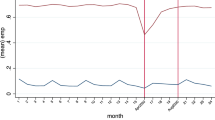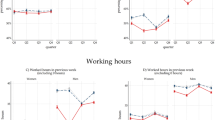Abstract
This study explored the gender gap in domestic labor at three time points, namely, before the pandemic (January 2020), during the early stages of the pandemic (May 2020), and more than one year after the expansion (May 2021). Using a two-wave social survey on work and family, this study observed no change in the gender gap in domestic labor for the majority of women and men in the early stages of the pandemic. Alternatively, the study noted a narrowing of the gender gap for 40–50% of the female and male respondents for housework and childcare one year after the outbreak of the pandemic. The associations between time availability, as well as relative resource factors and changes in the gender gap, were more clearly observed in the early stages of the pandemic than one year after the outbreak. Although this study observed a sign of a decline in gender gap for domestic labor one year after the outbreak of the pandemic, it is necessary to exercise caution and qualify such finding. Even in May 2021, a significant difference is still evident between women and men in their frequencies of all the domestic tasks. Furthermore, the data used in this study, which measures women’s and men’s involvement in housework and childcare based on frequency, may not adequately capture the increased burden of domestic labor on women, which had already been high even before the pandemic.
Access this chapter
Tax calculation will be finalised at checkout
Purchases are for personal use only
Similar content being viewed by others
Notes
- 1.
The Ministry of Education, Culture, Sports, Science and Technology (MEXT) announced that until December 2020, schools were temporarily closed after confirming positive cases of COVID-19 in schools. The closure was in effect according to the number of days necessary for local public health centers to test and identify people in close contact with COVID-19. After December 2020, the MEXT asked the schools to decide whether or not to close based on the status of the pandemic in the region and the opinion of the local public health centers, even when positive cases of COVID-19 were confirmed in schools.
- 2.
See Chap. 2 for details on the WLCV survey.
- 3.
In total, 21% of women and 18% of men experienced being furloughed between January and November 2020. Among those who experienced being furloughed, 63% of women were under nonregular employment, and 78% of men were under regular employment in May 2020. The average lengths of furlough was 37 and 19 days for women and men, respectively, and 60 and 72% of women and men, respectively, received allowances during the furlough.
- 4.
Three properties, namely, consistency, normality, and efficiency of maximum likelihood estimation, which are used in multinominal logit models, have been proven to hold as the sample size approaches ∞ (Long, 1997). Although Long does not provide an absolute standard for sample size when applying the maximum likelihood estimation, he cites that estimation for data with less than 100 samples is risky and that estimation is adequate when the sample size is >500. In this sense, although the estimation of data with a relatively small sample size in this study is not necessarily inappropriate, one should note that the results of the analyses must be validated with other data in further studies.
References
Ando, J. (2012). Tomokasegi fuufu no kajiroudou koudou no henka (Changes in dual-earner couples’ housework behavior: From the empirical analyses of cohort A in the JPSC. Niigata Kokusai Jouhou Daigaku Jouhou Bunka Gakubu Kiyou (journal of Niigata University of International and Information Studies), 15, 37–58.
Bae, J. (2009). Nihon to kankoku ni okeru dansei no ikuji sanka (Men’s participation in child-rearing in Japan and Korea). Keio Gijuku Daigaku Daigakuin Shakaigaku Kenkyuuka Kiyou (Studies in Sociology, Psychology and Education: Inquiries into Humans and Societies), 68, 59–73.
Brines, J. (1994). Economic dependency, gender, and the division of labor at home. American Journal of Sociology, 100(3), 652–688.
Carlson, D. L., Petts, R., & Pepin, J. R. (2021). Changes in US parents’ domestic labor during the early days of the COVID-19 pandemic. Sociological Inquiry, 92(3), 1–28.
Chin, M., Sung, M., Son, S., Yoo, J., Lee, J., & Chang, Y. E. (2020). Changes in family life and relationships during the COVID-19 pandemic and their associations with perceived stress. Family and Environment Research, 58(3), 447–461.
Craig, L., & Churchill, B. (2021). Dual-earner parent couples’ work and care during COVID-19. Gender, Work, and Organization, 28(S1), 66–79.
Del Boca, D., Oggero, N., Profeta, P., & Rossi, M. C. (2022). The impact of COVID-19 on the gender division of housework and childcare: Evidence from two waves of the pandemic in Italy. IZA Journal of Labor Economics, 11(1), 1–20.
Dunatchik, A., Gerson, K., Glass, J., Jacobs, J. A., & Stritzel, H. (2021). Gender, parenting, and the rise of remote work during the pandemic: Implications for domestic inequality in the United States. Gender and Society, 35(2), 194–205.
Hirai, M., & Watanabe, Y. (2021). Nyuyoji no chichioya ni okeru pandemic ni yoru hatarakikata no henka to kazoku to shigoto heno eikyo (The impact of COVID-19 on the family and working life of fathers with young children). Shinrigaku Kenkyu (Japanese Journal of Psychology), 92(5), 417–427.
Hupkau, C., & Petrongolo, B. (2020). Work, care and gender during the COVID-19 crisis. Fiscal Studies, 41(3), 623–651.
Ishibashi, S., Takeda, R., & Taniguchi, M. (2021). COVID-19 ga kosodate yushikisha no gender-gap ni oyoboshita eikyo: Kinkyujitai sengen mae/ chu/ go 3danmen deno kaji, ikuji jikan ni chakumoku site (Impact of Covid-19 on the gender gap among experts on child care: Focusing on housework and childcare time in three phases before, during, and after the declaration of a state of emergency). Toshikeikaku Ronbun Shu (Journal of City Planning Institute of Japan), 56(3), 641–648.
Ishii-Kuntz, M., & Coltrane, S. (1992). Predicting the sharing of household labor: Are parenting and housework distinct? Sociological Perspectives, 35(4), 629–647.
Kamo, Y. (1988). Determinants of household labor: Resources, power, and ideology. Journal of Family Issues, 9(2), 177–200.
Kamo, Y. (2000). “He Said, She Said”: Assessing discrepancies in husbands’ and wives’ reports on the division of household labor. Social Science Research, 29(4), 459–476.
Kim, J., & Choi, Y. (2021). “코로나19 시기 가족관계 만족도 변화는 어떻게 설명할 수 있는가?: 남성 가사분담의 역할을 중심으로 (What enhances family relationship satisfaction during the COVID-19 pandemic?: The moderating influence of men’s division of domestic labor). 비판사회정책 (Journal of Critical Social Policy), 70, 101–132.
Kuroda, T. (2020). Shingata korona no kagaku: Pandemikku, soshite kyousei no mirai he (The science of the COVID-19: Pandemic and toward a future of co-existence). Chuokoron-Shinsya.
Long, J. S. (1997). Regression models for categorical and limited dependent variables. Sage Publications.
Lyttelton, T., Zang, E., & Musick, K. (2021). Telecommuting and gender inequalities in parents’ paid and unpaid work before and during the COVID-19 pandemic. Journal of Marriage and Family, 84(1), 230–249.
Matsuda, S. (2000). Otto no kaji ikuji sanka no kitei youin (Husbands’ participation in domestic work). Nenpou Shakaigaku Ronshuu, 13, 134–145.
Matsuda, S. (2006). Kinnen ni okeru chichioya no kaji ikuji sanka suijun to kitei youin no henka (The changes in fathers’ participation in housework and childcare in recent years). Kakei Keizai Kenkyuu (Japanese Journal of Research on Household Economics), 71, 45–54.
Ministry of Internal Affairs and Communications, Japan. (2021). Reiwa 3 nenban jouhou tsuushin hakusho (White paper information and communications in Japan, 2021). Retrieved from https://www.soumu.go.jp/johotsusintokei/whitepaper/ja/r03/pdf/index.html. Accessed on 24 Nov 2022.
Ochiai, E., & Suzuki, N. (2020). COVID-19 kinkyuu jitai sengen ka ni okeru zaitakukinmu no jittai chousa: Kazoku oyobi gendaa he no kouka wo chuushin ni (Working from home during the COVID-19 pandemic: Results of a survey on the effects of staying at home on the family and gender relations in Japan). Kyoto Syakaigaku Nenpou (Kyoto Journal of Sociology), 28, 1–13.
Sasaki, S. (2018). Waaku raifu baransu jidai ni okeru dansei no kaji ikuji jikan no kitei youin tou ni kansuru jisshou bunseki (Determinant factors for time spent on housework by men). Seikatsu Keizaigaku Kenkyuu (Journal of Household Economics), 47, 47–66.
Sevilla, A., & Smith, S. (2020). Baby steps: The gender division of childcare during the COVID-19 pandemic. Oxford Review of Economic Policy, 36(Supplement_1), S169–S186.
Shafer, K., Scheibling, C., & Milkie, M. A. (2020). The division of domestic labor before and during the COVID-19 pandemic in Canada: Stagnation versus shifts in fathers’ contributions. Canadian Review of Sociology, 57(4), 523–549.
Shelton, B. A., & John, D. (1996). The division of household labor. Annual Review of Sociology, 22, 299–322.
Statistics Bureau of Japan. (2022). Reiwa 3 nen shakaiseikatu kihon chousa: Seikatsu jikan oyobi seikatsu koudou ni kansuru chousa, kekka no gaiyou (Report of 2021 survey on time use and leisure activities). Retrieved from https://www.stat.go.jp/data/shakai/2021/pdf/gaiyoua.pdf. Accessed 10 Dec 2022.
Yokomaku, T. (2020). Kinkyuu jitai sengen ka ni okeru huuhu no kaji ikuji buntan (Sharing of housework and childcare for couples under a state of emergency). Mitsubishi UFJ Research & Consulting. Retrieved from https://www.murc.jp/wp-content/uploads/2020/05/survey_covid-19_200526.pdf. Accessed on 20 Jan 2021.
Zhou, Y. (2020). Shingata korona uirusu to koyou, kurashi ni kansuru NHK JILPT kyoudou chousa kekka gaiyou: josei no kibishii koyou joukyou ni chuumoku shite (Summary of the results from NHK/JILPT joint survey on COVID-19, employment, and living: Focusing on the severe employment situation of women). Retrieved from https://www.jil.go.jp/tokusyu/covid-19/collab/nhk-jilpt/docs/20201113-nhk-jilpt.pdf. Accessed on 20 Feb 2021.
Acknowledgements
This work was supported by JSPS KAKENHI Grant Number JP18H00936.
Author information
Authors and Affiliations
Corresponding author
Editor information
Editors and Affiliations
Rights and permissions
Copyright information
© 2023 The Author(s), under exclusive license to Springer Nature Singapore Pte Ltd.
About this chapter
Cite this chapter
Nishimura, J., Bae, J., Toma, K. (2023). Impact of the COVID-19 Pandemic on the Gender Gap in Domestic Labor: Evidence from a Two-Wave Survey in Japan. In: Matsuda, S., Takenoshita, H. (eds) Changes in Work and Family Life in Japan Under COVID-19. SpringerBriefs in Population Studies(). Springer, Singapore. https://doi.org/10.1007/978-981-99-5850-4_3
Download citation
DOI: https://doi.org/10.1007/978-981-99-5850-4_3
Published:
Publisher Name: Springer, Singapore
Print ISBN: 978-981-99-5849-8
Online ISBN: 978-981-99-5850-4
eBook Packages: Social SciencesSocial Sciences (R0)




